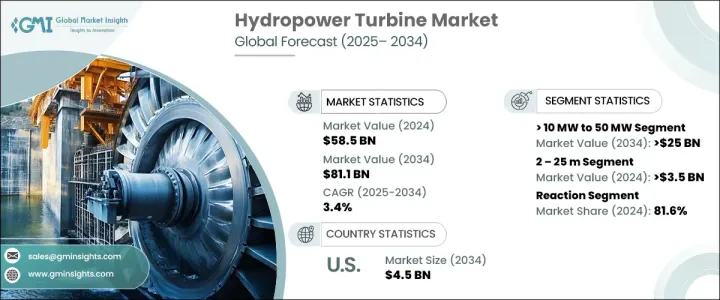PUBLISHER: Global Market Insights Inc. | PRODUCT CODE: 1716496

PUBLISHER: Global Market Insights Inc. | PRODUCT CODE: 1716496
Hydropower Turbine Market Opportunity, Growth Drivers, Industry Trend Analysis, and Forecast 2025 - 2034
The Global Hydropower Turbine Market generated USD 58.5 billion in 2024 and is projected to grow at a CAGR of 3.4% between 2025 and 2034. The growing global demand for reliable and sustainable electricity sources is fueling this expansion. Hydropower, known for its ability to generate clean energy on a large scale, is becoming a preferred solution to meet the rising electricity needs of both developing and developed nations. The increasing emphasis on reducing carbon emissions, coupled with government policies promoting renewable energy adoption, is further strengthening the market. Hydropower offers unparalleled reliability and flexibility, making it an ideal complement to other renewable sources like wind and solar energy.

Additionally, advancements in turbine technology are significantly improving operational efficiency, reducing maintenance costs, and enhancing the overall sustainability of hydropower projects. This, along with the modernization of aging infrastructure, is propelling the market forward. Governments and private entities are investing heavily in upgrading hydropower plants to meet growing energy demands while ensuring minimal environmental impact. The increasing adoption of small and micro hydropower systems in rural and off-grid regions is also contributing to market growth, offering decentralized power solutions in areas with limited access to traditional power grids.
| Market Scope | |
|---|---|
| Start Year | 2024 |
| Forecast Year | 2025-2034 |
| Start Value | $58.5 Billion |
| Forecast Value | $81.1 Billion |
| CAGR | 3.4% |
The market is segmented based on turbine capacity, with key categories including <= 1 MW, > 1 MW to 10 MW, > 10 MW to 50 MW, and > 50 MW. The > 10 MW to 50 MW segment is expected to generate USD 25 billion by 2034. These turbines are preferred for their ability to provide large-scale power output, making them ideal for high-demand applications in densely populated urban areas and industrial zones. Their role in grid stabilization and consistent power delivery under varying load conditions makes them indispensable for meeting large-scale energy requirements. This segment is experiencing strong growth as utilities and governments focus on enhancing grid reliability and supporting industrial expansion.
Another key segment is based on turbine type, categorized into impulse and reaction turbines. In 2024, the reaction turbine segment accounted for 81.6% of the market share. Reaction turbines are highly efficient for medium to large-scale projects, especially in regions with variable water flow rates. Their eco-friendly design minimizes ecological disruption and supports sustainable energy generation. As governments and utilities seek to replace older, less efficient turbines with advanced models, the demand for reaction turbines is poised to grow. Their ability to handle higher water pressures and adapt to different operating conditions makes them a preferred choice for hydropower developers.
The U.S. Hydropower Turbine Market was valued at USD 4.4 billion in 2024. The country is witnessing an increasing focus on distributed energy resources and the development of small and micro hydropower projects. Government incentives aimed at expanding renewable energy infrastructure and promoting off-river hydropower projects are driving this growth. Additionally, collaborative efforts between public and private sectors are fostering technological innovation and enhancing the deployment of hydropower systems. These initiatives are positioning the U.S. as a key player in advancing hydropower technology and contributing significantly to the global market.
Table of Contents
Chapter 1 Methodology & Scope
- 1.1 Market scope & definitions
- 1.2 Market estimates & forecast parameters
- 1.3 Forecast calculation
- 1.4 Data sources
- 1.4.1 Primary
- 1.4.2 Secondary
- 1.4.2.1 Paid
- 1.4.2.2 Public
Chapter 2 Executive Summary
- 2.1 Industry synopsis, 2021 - 2034
Chapter 3 Industry Insights
- 3.1 Industry ecosystem analysis
- 3.2 Regulatory landscape
- 3.3 Industry impact forces
- 3.3.1 Growth drivers
- 3.3.2 Industry pitfalls & challenges
- 3.4 Growth potential analysis
- 3.5 Porter's analysis
- 3.5.1 Bargaining power of suppliers
- 3.5.2 Bargaining power of buyers
- 3.5.3 Threat of new entrants
- 3.5.4 Threat of substitutes
- 3.6 PESTEL analysis
Chapter 4 Competitive Landscape, 2024
- 4.1 Introduction
- 4.2 Strategic outlook
- 4.3 Innovation & sustainability landscape
Chapter 5 Market Size and Forecast, By Capacity, 2021 - 2034 (MW & USD Million)
- 5.1 Key trends
- 5.2 ≤ 1 MW
- 5.3 > 1 MW to 10 MW
- 5.4 > 10 MW to 50 MW
- 5.5 > 50 MW
Chapter 6 Market Size and Forecast, By Head, 2021 - 2034 (MW & USD Million)
- 6.1 Key trends
- 6.2 2 – 25 m
- 6.3 > 25 – 70 m
- 6.4 > 70 m
Chapter 7 Market Size and Forecast, By Product, 2021 - 2034 (MW & USD Million)
- 7.1 Key trends
- 7.2 Impulse
- 7.3 Reaction
Chapter 8 Market Size and Forecast, By Region, 2021 - 2034 (MW & USD Million)
- 8.1 Key trends
- 8.2 North America
- 8.2.1 U.S.
- 8.2.2 Canada
- 8.2.3 Mexico
- 8.3 Europe
- 8.3.1 France
- 8.3.2 Austria
- 8.3.3 Norway
- 8.3.4 Russia
- 8.3.5 Italy
- 8.3.6 Switzerland
- 8.3.7 Turkey
- 8.3.8 Sweden
- 8.4 Asia Pacific
- 8.4.1 China
- 8.4.2 India
- 8.4.3 Vietnam
- 8.4.4 Bhutan
- 8.4.5 Indonesia
- 8.4.6 Nepal
- 8.4.7 Sri Lanka
- 8.5 Middle East & Africa
- 8.5.1 Ethiopia
- 8.5.2 Iran
- 8.5.3 Israel
- 8.5.4 Nigeria
- 8.5.5 Zambia
- 8.6 Latin America
- 8.6.1 Brazil
- 8.6.2 Peru
- 8.6.3 Argentina
Chapter 9 Company Profiles
- 9.1 ANDRITZ
- 9.2 B fouress
- 9.3 Dobriyal Brothers
- 9.4 GE Vernova
- 9.5 Gilkes
- 9.6 GUGLER Water Turbines
- 9.7 Jyoti
- 9.8 Litostroj Power
- 9.9 Mitsubishi Heavy Industries
- 9.10 Natel Energy
- 9.11 Pentaflo Hydro
- 9.12 Siemens Energy
- 9.13 Toshiba
- 9.14 Turbiwatt
- 9.15 Voith




